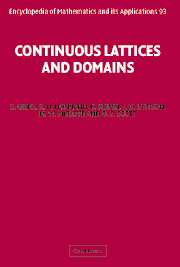Book contents
- Frontmatter
- Contents
- Preface
- Acknowledgments
- Foreword to A Compendium of Continuous Lattices
- Introduction to A Compendium of Continuous Lattices
- O A Primer on Ordered Sets and Lattices
- I Order Theory of Domains
- II The Scott Topology
- III The Lawson Topology
- IV Morphisms and Functors
- V Spectral Theory of Continuous Lattices
- VI Compact Posets and Semilattices
- VII Topological Algebra and Lattice Theory: Applications
- Bibliography
- List of Symbols
- List of Categories
- Index
I - Order Theory of Domains
Published online by Cambridge University Press: 13 August 2009
- Frontmatter
- Contents
- Preface
- Acknowledgments
- Foreword to A Compendium of Continuous Lattices
- Introduction to A Compendium of Continuous Lattices
- O A Primer on Ordered Sets and Lattices
- I Order Theory of Domains
- II The Scott Topology
- III The Lawson Topology
- IV Morphisms and Functors
- V Spectral Theory of Continuous Lattices
- VI Compact Posets and Semilattices
- VII Topological Algebra and Lattice Theory: Applications
- Bibliography
- List of Symbols
- List of Categories
- Index
Summary
Here we enter into the discussion of our principal topics. Continuous lattices and domains exhibit a variety of different aspects, some are order theoretical, some are topological, some belong to topological algebra and some to category theory – and indeed there are others. We shall contemplate these aspects one at a time, and this chapter is devoted entirely to the order theory surrounding our topic.
Evidently we have first to define continuous lattices and domains. As we shall see from hindsight, there are numerous equivalent conditions characterizing them. We choose the one which is probably the simplest, but it does involve the consideration of an auxiliary transitive relation, definable in every poset, by which one can say that an element x is “way below” an element y. We will write this as x « y. We devote Section I-1 to the introduction of the way-below relation and of continuous lattices and domains. We demonstrate that the occurrence of this particular additional ordering is not accidental and explain its predominant role in the theory. We exhibit the paradigmatic examples of continuous lattices and domains; in due course we shall see many more.
In Section I-2 we show that continuous lattices have a characterization in terms of (infinitary) equations. This gives us the important information that the class of continuous lattices, as an equational class, is closed under the formation of products, subalgebras, and homomorphic images – provided we recognize from the equations which maps ought to be considered as homomorphisms.
- Type
- Chapter
- Information
- Continuous Lattices and Domains , pp. 48 - 130Publisher: Cambridge University PressPrint publication year: 2003



